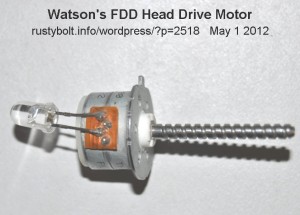 I’ve taken apart many disk drives, CD drives and floppy drives. The magnets are awesome! Another fun part is the motor. In the case of floppies and CDs, the head stepper motor is small, relatively powerful for its size, and can be used as a generator to drive a red LED connected directly to it (see the picture). The motor that drives the door opening mechanism and the disk drive motor will also generate enough power to drive a LED, but the voltage may be too low; a Joule Thief may have to be added to boost the voltage enough to light the LED.
I’ve taken apart many disk drives, CD drives and floppy drives. The magnets are awesome! Another fun part is the motor. In the case of floppies and CDs, the head stepper motor is small, relatively powerful for its size, and can be used as a generator to drive a red LED connected directly to it (see the picture). The motor that drives the door opening mechanism and the disk drive motor will also generate enough power to drive a LED, but the voltage may be too low; a Joule Thief may have to be added to boost the voltage enough to light the LED.
I soldered the red LED directly to two of the four pins of the head stepper motor in the picture. I can spin the shaft with my fingers and the LED will briefly light up brightly. The shaft is too small and unwieldy to spin with the fingers for any length of time. I could tie some heavy string or dental floss between the ends of a straightened out paper clip to make a sort of bow. Then I could wrap a turn or two around the shaft of the motor, and by moving the bow, the shaft would spin and light the LED continuously – well almost.
Clocks and Ideas for Clocks Bill “Botronics” Sherman sent me a link to his Nixie Clock project. It uses a single Nixie numeric tube to flash the digits of the time one after the other. The brains of the circuit is a microcontroller that divides the crystal frequency and outputs the correct digits. He got some of the project from another Nixie clock seen here. I viewed some of this other guy’s clocks and found them interesting. One that is intriguing is the clock that uses an analog wiggle stick meter to display the digits – very retro; the meter may be more than 50 years old.
This got me to thinking about other alternative ways to display the time (Thanks, QS). These small stepper motors from disk drives could turn a small disk with the numbers on it to indicate the time. The clock would be even simpler than a Nixie clock. All that is needed are a precision one second pulse source, a few stepper motors, some reed switches and magnets, and some heavy cardboard for the disks with the numbers. The pulse would drive the seconds stepper motor and its associated disk. The seconds disk would have a small magnet glued to the back of the disk, which passes by the reed switch every full revolution. This pulse would then step the tens of seconds disk, and so on for the minutes and hours. Some circuitry would be needed to make the stepper motor stepping pulses (the drive board from a battery operated clock?). But I don’t think any microcontroller would be needed. To set the time, the wheels could be turned by hand to the correct time.
I suppose the clock could be reduced to a single disk, like the Nixie clock. But it would need a way of telling where the disk is as it spins around from one digit to the next. That’s the nice thing about using several disks: since time always progresses from one second to the next, all that has to be done is to step the disk to the next digit.
I had another brainstorm about a clock. There’s nothing that says that the dial has to be a circle with big hand and little hand, etc. We may have seen the table clocks with the digits that are on little plastic tabs that flip down every minute and then disappear behind the next one. Well, I thought that it might be possible to make an analog display by putting a piece of old 16mm film on sprockets and have a LED shine from behind to illuminate the digit on the film. The film would be long enough to have a digit every 10mm, so 600 mm length for the seconds and minutes, and 120 or 240 mm for the hours. The clock could be made to be very narrow, and long enough to accommodate the strips of film. Seconds could be roughly gauged by small tick marks on the edge of each digit.
Here is another really cool clock, one that tells the time anywhere in the world, and whether it is daytime or nighttime.
Here is another link that I found that shows a guy’s unique computer project. Wow, that must be noisy!
Comments? Send to my Yahoo.com email address, acmefixer